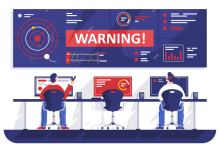
It jumped out at me as big news: Lack of and/or bad desktop tools took the #1 spot on our challenges list for 2019. That data confirms what we see in countless projects. Centers have many applications and a plethora of communication tools. They also have messy applications that are not integrated or well suited to the workflow of the contact center.
It doesn’t have to be this way! There are plenty of ways to integrate and simplify the agent’s world and improve the outcomes of each contact.
CRM is an option for those that have it or are considering it (typically for other reasons). A “Unified Agent Desktop” (UAD) solution can be a transformational tool for those not ready, willing, or able to tackle the bigger goals of a CRM project. A UAD can provide “CRM-lite” capabilities while helping to address the mess that I described earlier. While “build” is not usually our preference for anyone to solve contact center technology problems, bigger shops with a strong IT department could consider such an approach.
In any case, contact center leadership needs to work with IT on a requirements and planning effort that focuses on the workflows and integration needs of the contact center. An inventory of the tools in use today, along with what information is needed and where it resides, gets things started. Use the top contact types to outline what happens today. Then it’s time to question everything as you envision a new desktop.
I like “phoenix” exercises for projects like this, imagining what that desktop would look like if it were built from scratch, specifically to meet the needs of the contact center in handling the various contact types. The CRM or UAD or newly built desktop can become the “cockpit” only if approached with that goal and with an open mind to how to change the way agents navigate and access the information needed to address various customer needs. You may even realize you don’t need some legacy systems (gasp!) as they linger only for small amounts of information that everyone knows just needs to be moved somewhere else.
While you’re cleaning things up, don’t forget about gaps. One of the most common ones is Knowledge Management (KM), because the SharePoint sites and “intranets” or “portals” that have been cobbled together often aren’t cutting it. Agents need it to succeed, particularly in environments with complexity and diversity in products and services, and/or with constantly changing information. Key characteristics include good search capability, “bite-sized” info that can be consumed quickly in the real-time world of a call, feedback loops, and continuous updates.
Omnichannel is another key element of a better desktop. We have touted the benefits of common routing engine many times. It creates one place where agents go to manage contacts (login/logout, change workstates, get the next contact that matches their skills, have visibility to their performance and the current status across media, etc.). It also helps manage the distribution of workload—routing, reporting, planning, scheduling, etc. But the reality is centers have to make decisions between ACD and CRM, as well as standalone solutions (e.g., for chat), because of the mix of tools in place.
So, when it comes to your pursuit of a good omnichannel desktop, carefully review the options that make the most sense for your environment based on what you have (or are pursuing) and how you manage contacts and the associated agent skills. Strive toward a common routing and reporting engine but adapt where needed and make sure the processes and organizational plan align with the technology choices (so the burden isn’t on the agent).
For example, some people separate the “digital channels” (email, chat, text/SMS) and may manage all of them in a CRM solution, while voice is managed separately in the “phone system.” Regardless, your approach should avoid agents acting as the integration point. When agents handle voice and email and chat and must constantly update status in multiple tools to avoid a barrage of simultaneous contacts, they have little chance of success.



